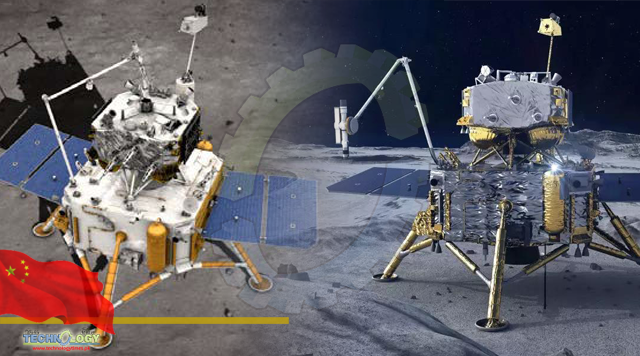After weeks of space travel, China’s Chang’e-5 probe has come back to Earth with fresh lunar rock and soil samples on Thursday morning, Beijing Time.

The precious cargo is the first lunar samples that humanity has obtained in more than four decades.
The returner capsule landed at the designated landing site in Siziwang Banner in north China’s Inner Mongolia Autonomous Region. The search and recovery team on the ground, which had conducted multiple simulation drills before, moved quickly to locate the target and retrieve the capsule.
An air team on board helicopters spotted the capsule using infrared cameras, while a ground team followed up in SUVs to reach the snow-covered landing site.
As planned, the capsule with lunar samples inside will be transported to Beijing by air and opened there. In Beijing, the China National Space Agency (CNSA) will transfer the lunar materials to a lunar sample laboratory at the National Astronomical Observatory (NAO) under the Chinese Academy of Sciences, which has been built specially for its storage, processing and analysis.
The lab has special facilities that will prevent the sample from being contaminated by the atmosphere and water on Earth. Scientists at the lab will first unpack, sort out and store the materials. They will then start long-term studies of the sample as per strict and scientific experiment design, including analyzing its mineralogical and chemical makeup.
Chinese President Xi Jinping lauded the success of the China’s Chang’e-5 mission in a congratulatory letter to all those who contributed to the historic achievement.
He called the mission China’s most complicated space project and the success of the mission another major achievement in overcoming difficulties by giving full play to the advantages of the new nationwide system.
It marks a great step forward in China’s space industry and will contribute to deepening the understanding of the origin of the moon and the evolution history of the solar system, Xi noted.
Comprising a lander, an ascender, an orbiter and a returner, the China’s Chang’e-5 probe was launched on November 24. Its lander-ascender combination successfully landed on the near side of the moon on December 1, and collected samples from both the lunar surface and beneath.
All you need to know about the lunar sample taken back by Chang’e-5
Here is what we know so far about the sample, which could prove key to unlocking many mysteries about the moon.
Where was the sample taken from?
The landing site of China’s Chang’e-5 was Mons Rümker, a 70-kilometer-wide volcanic mound in the region known as Oceanus Procellarum (Latin for “Ocean of Storms”) on the moon’s near side – the vast, dark lava plains visible from Earth with the naked eye.
It’s a place untouched by humanity.
The lander shoveled up some surface material and also drilled a 2-meter-deep hole and scooped up soil and rock from inside it.
The landing sites of Chang’e-5 and previous lunar landing missions by the U.S./NASA
Why collect samples from Mons Rümker?
In the late 1960s and 1970s, the United States brought back to Earth 382 kilograms of lunar material from six moon-landing missions, while the former Soviet Union retrieved 300 grams over three missions.
All those samples are very old – 3 to 4 billion years in age. Analysis of the samples suggests that volcanic activity on the moon peaked 3.5 billion years ago, then faded away and stopped.
But Mons Rümker, where Chang’e-5 collected its sample, may have erupted as recently as about 1.3 billion years ago and contain “the youngest mare basalt on the moon,” according to scientists. Such “young” rocks from the moon have never yet been sampled or studied.
If Chang’e-5’s samples confirm that the moon was still active during this time, it could fill an important gap in scientists’ understanding of the moon’s volcanic activity, and rewrite the history of the moon.
Studying the rocks’ composition could also clarify what fueled this thermal activity for so long. “The landing site was extremely wisely picked,” HaraldHiesinger, a geologist at the University of Münster in Germany, told Nature.
Brett Denevi, a planetary geologist at Johns Hopkins University in the U.S. and science chair of a NASA lunar analysis group, said China picked a spot where it could have a big scientific impact.
“Understanding the age of those samples and all of the Solar System–wide implications that flow from that result will be a big leap forward for planetary science,” she was quoted as saying in Science magazine.
The landing sites of Chang’e-5 and previous spacecraft from the U.S. and Russia. /CNSA
How will the sample be handled?
In order to properly handle and study this precious material, China has built a lunar sample laboratory at the National Astronomical Observatory (NAO) under the Chinese Academy of Sciences in Beijing, dedicated to its storage, processing and analysis.
Once it has landed on Earth, the sample will be transferred to the lab in a sealed container. The lab has a special facility that will prevent the sample from being contaminated by the atmosphere and water on Earth.
Scientists at the lab will first unpack, sort out and store the material. They will then conduct long-term studies of the sample as per strict and scientific experiment design, including analyzing its mineralogical and chemical makeup.
Some of the sample will also be set aside for public display, according to Li Chunlai, deputy chief designer of the Chang’e-5 mission.